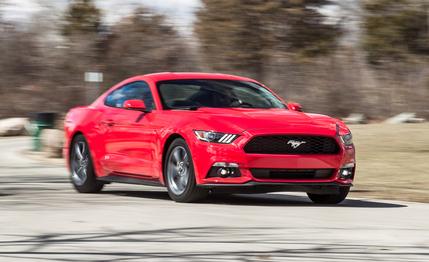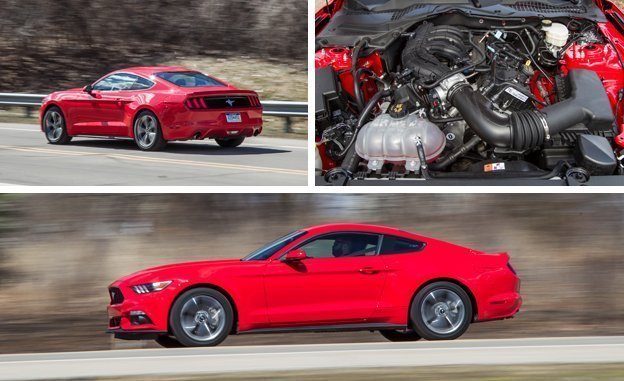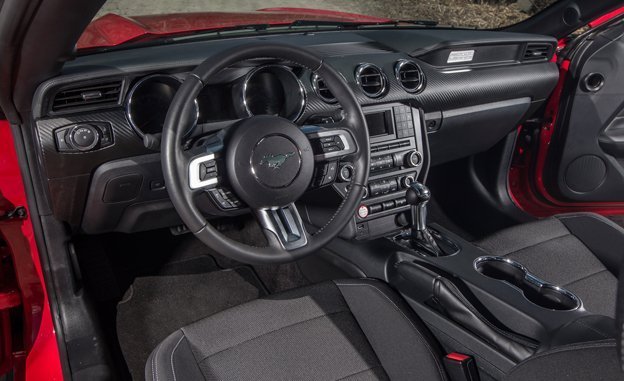
 Instrumented Test
From the August 2015 issue
Instrumented Test
From the August 2015 issue
A rear-drive sports coupe for less than 25 grand is a rare and alluring thing. But Ford’s marketing neglect of the base Mustang in favor of the new EcoBoost four-cylinder relegates the V-6 to the clearance rack. In addition to having the latest pony car’s revised chassis, which includes a new independent rear suspension and impressive overall refinement, this V-6 coupe is the lightest of the new Mustangs we’ve tested. At 3588 pounds, it weighs 100 pounds less than the EcoBoost versions we’ve driven.
Its motivation comes from the Blue Oval’s familiar 3.7-liter port-injected V-6, tuned here for 300 horsepower and 280 pound-feet of torque. A six-speed manual transmission is standard, but our example sported the optional six-speed auto, which adds $1195 to the sticker.

 By limiting performance and convenience options, Ford has hobbled the V-6 Mustang. It will make an excellent rental car, though.
By limiting performance and convenience options, Ford has hobbled the V-6 Mustang. It will make an excellent rental car, though.
With less torque at a higher rpm peak than the turbo 2.3, which makes 310 ponies and 320 pound-feet, the V-6 requires greater footwork from the driver to build speed. Still, it matched the manual EcoBoost version to 60 mph (5.5 seconds) and was only a few ticks slower than the automatic turbo. The V-6’s 14.1-second quarter-mile only slightly trails the four-cylinder. What’s more, the V-6 auto’s observed 22 mpg was about the same as that of the turbocharged Mustangs we’ve driven.
However, Ford won’t let you add the new Mustang’s Performance package unless you pony up $1500 for the EcoBoost mill or buy a GT, which means forgoing a stiffer suspension and the upgraded steering, chassis, and brakes. Also prohibited: 19-inch wheels with performance tires.
The V-6’s Goodyear all-seasons still offer solid composure and are compliant over rough surfaces, and a limited-slip differential with a spunky 3.55:1 final drive is available (our test car had the standard 3.15:1 ratio). But the V-6 lacks the directness and tactility provided by the EcoBoost’s optional go-fast hardware. Lateral grip drops to a still-respectable 0.86 g, and 70–0 stops stretch to 164 feet. Factor in our car’s clumsy automatic, which was quick to reach top gear and slow to downshift even in sport mode, and the V-6 simply isn’t as much fun as the other engines.


The trade-off for all this is the V-6 coupe’s affordable MSRP of $24,625, with our car reaching $27,700 with the autobox and several small options. The new Mustang’s cabin is a huge improvement over its predecessor’s, and the standard cloth seats offer good comfort and support, so it’s no penalty box. But here, too, Ford denies V-6 buyers the Premium trim level’s leather upholstery, touch-screen interface, and other amenities available on the EcoBoost and GT models. Are you getting the feeling that Ford doesn’t want you to buy a V-6 unless you’re Hertz or Avis?
With the new base car geared mainly to fleets and bargain shoppers, Ford’s EcoBoost emphasis penalizes the price-conscious Mustang enthusiasts who would likely appreciate the V-6’s raspy exhaust note over the EcoBoost’s flat, synthetic soundtrack. That’s a reason to be angry at the Ford suits, but at least the V-6 Mustang should be a prime contender if we dare to host a second Rental Car Olympics.